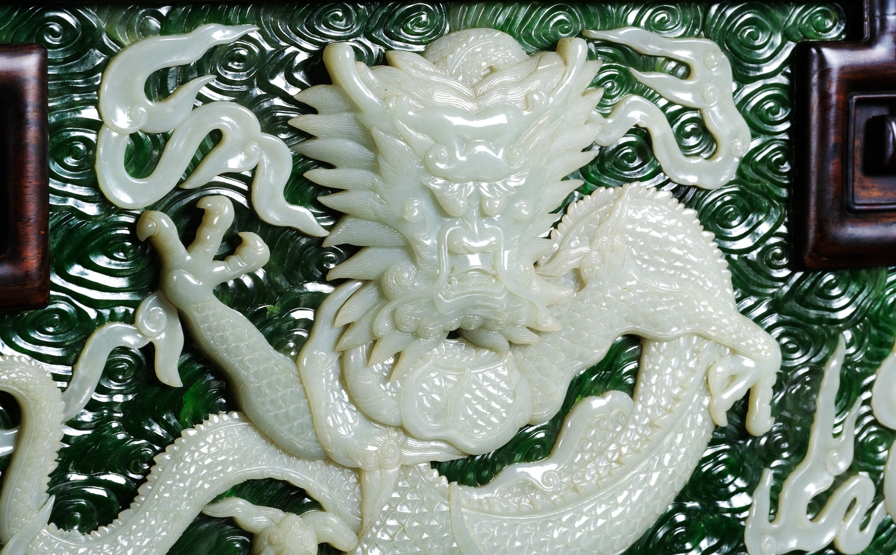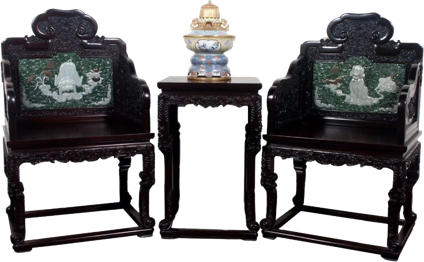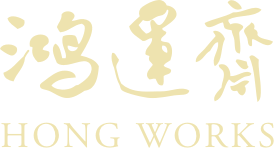- Collections 0
- Articles 0

Emperor Qianlong's Padauk Throne with Carved Jade and Enamel Inlaid was made in his twilight years during the Qing Dynasty. It embodies the best craftsmanship of making rosewood furniture at that time, and is known as a cultural relic of nation level I. It has always been kept in the basement of the Palace Museum. Only once upon last year the throne flashed briefly into the public.
At the beginning of this century, cooperating with the Palace Museum, Hong Works made the replica of some cultural relics. Due to its exquisite craftsmanship, the reproduction was highly appreciated by the related experts. The replica of Emperor Qianlong's Padauk Throne with Carved Jade and Enamel Inlaid, which values more than a hundred million yuan, is one of them. This national treasure has 3 outstanding differences:

Craftsmanship of inlaying jade on a trenched surface according to its outline (the inlaid jade and the surface look like on the same level)(almost lost)
Different from the stereoscopic openwork carving and relief, this almost-lost craftsmanship focuses highly on the technique of piecing. In order to pursue perfection, the joints of each single jade piece are not flat but resemble toothed gear, outlined according to its shape. This is the characteristics of jade carving during Emperor Qianlong’s reign (1711-1799), namely deluxe jade, large-sized ware and complicated craftsmanship. This technique makes the jade work delicate and look like a natural complete piece. To have a command of high-level jade carving skill is a must for the artisan. For instance, a soybean-sized piece of green jade needs to be inlaid onto the tiny blank nearby dragon claws. The artisan has to fix the little jade piece in-between his fingers and carve it on the machine. This craftsmanship is finally revived by the cooperation of several jade carving masters.
Craftsmanship of rosewood hidden mortise and tenon joint structure
Chinese traditional furniture is divided into 3 categories, namely “Beijing Style”, “Canton Style” and “Suzhou Style”. Among them, “Suzhou Style” is highly appreciated by Emperor Qianlong for its exquisite carving and complicated craftsmanship. This throne, with the measurement of 109cm in length, 84cm in width and 104cm in height, weighs 1 ton for its major material of padauk. For such a giant piece of furniture, it only consists of some 30 joint structures of mortise and tenon with the absence of a single nail.
Top overall Chinese Fengshui arrangement
Emperor Qianlong was the emperor who had been in power for the longest time in Chinese history (1711-1799), and established one of the greatest heydays, namely “Kang Qian Flourishing Age”. He had achieved many accomplishments in his life. He had been living up to 89 years old and the longest life among all the Chinese emperors in history, with 27 children (17 sons and 10 daughters). Therefore, he was blessed with good fortune, high salary and long life. Emperor Qianlong paid much attention to his household goods according to Chinese Fengshui, especially the throne, which symbolized his supreme power. The dragon pattern on this padauk throne with carved jade inlaid is a comprehensive expression of Fengshui, which made the throne one of the best choices for the emperor.
In addition, the materials to make this replica are finely selected, including the rosewood of padauk, the white jade of Hetian, the green jade of Canada, the enamel of Beijing, the goldleaf of Nanjing, etc. With the cooperation of more than 100 skilled craftsmen from Shanghai, Suzhou, Nanjing and Dongyang, the reproduction was finally made after one year, and was highly appreciated by Mr. Cao Jinglou and Mr. Hu Desheng, experts of Ming and Qing Dynasties’ furniture from the Palace Museum. Due to the high cost of time, manpower and wealth, Hong Works has made only 3 pieces. 2 of them were collected by domestic top collectors, and 1 was shown as an exhibit at Hong Works’ studio (known as Fortune Club) for its members.
It is worth mentioning that after the project of reproducing the national treasure, an idea suddenly came into the mind of Mr. Huang, founder and art creator in chief. Together with his team, he then designed and made this set of armchairs with jade inlaid in the pattern of 12 Zodiac animals. According to the study of Chinese imperial Fengshui, the masters of arts and crafts delicately painted the pictures of 12 Zodiac animal, on the basis of 3 “secret techniques” of the throne. Though different from the replica of Emperor Qianlong's Padauk Throne, which costs more than 1 million US dollars and around 1 year to make, due to its complicated craftsmanship, the annual output of this set of armchairs is very limited. Because of its scarcity and practicability, the value of these armchairs is among the very few art investments during the last 10 years compared with the price of the real estate in the big cities in China. In 2005, Mr. Xiao Yanyi, Deputy Director of the Palace Museum of the time, was amazed by the design and craftsmanship of this set of armchairs with the pattern of 12 Zodiac animals, which had similar characteristics of the imperial furniture. And then, this set of armchairs was collected by the Palace Museum for the first time ever since its establishment 80 years ago, despite its manifesto of refusing to collect rosewood furniture manufactured in modern times.
 (Rosewood Armchairs with Carved Jade Inlaid in Pattern of 12 Zodiac Animals)
(Rosewood Armchairs with Carved Jade Inlaid in Pattern of 12 Zodiac Animals)
No matter the replica of Emperor Qianlong's Padauk Throne with Carved Jade and Enamel Inlaid, or the set of armchairs with pattern of 12 Zodiac animals (with its design originated from the throne), both of them, with their finely selected materials and particular civilization, explain the everlasting aim of Hong Works: creating Chinese beauty that can transcend time.


